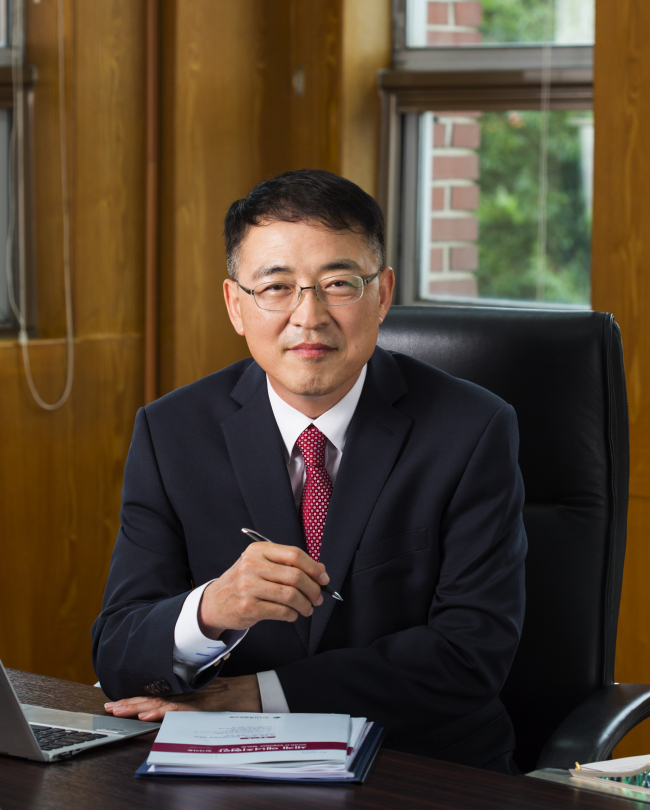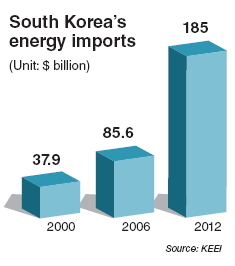Time to adopt consumer-driven energy policy, expert says
By Seo Jee-yeonPublished : Oct. 13, 2013 - 19:59
Natural resource-deficient Korea has long been dependent on the government-led, supply-driven, cheap electricity policy as stability in power supply has been seen as a crucial pre-condition of economic development.
“The energy policy worked well when the Korean economy was in a developing stage, but it started facing a limit from the 1990s when the economy became much bigger,” Korea Energy Economics Institute president Sonn Yang-hoon said.
“The energy policy worked well when the Korean economy was in a developing stage, but it started facing a limit from the 1990s when the economy became much bigger,” Korea Energy Economics Institute president Sonn Yang-hoon said.

The supply-driven energy policy pushed Korea to the top of the tables in onshore power plant density, and Korea now lacks space for additional power plant construction. This is one of the reasons why the government cannot easily rush to expand supply, despite repeated power shortages in peak seasons for the past few years.
Another big challenge in the Korean energy sector is the soaring cost of energy imports, triggered not only by rising power demand but also rising fuel prices, in particular, international oil prices. Korea imports more than 90 percent of the energy it uses to generate power.
A KEEI survey showed the nation’s energy imports amounted to $185.3 billion last year, a 500 percent increase from 2000.
“Last year, energy imports exceeded combined outbound shipments of the nation’s top three export items ― semiconductor products, cars and ships, which amounted to $132.6 billion,” Sonn said.

One possible path to policy transition is to introduce competition to the electricity sales market where Korea Power Exchange under the Korea Electric Power Corp. dominates.
“When competition is brought into the electricity sales market, more innovative, technology-based energy solutions will be introduced in the market to appeal to consumers. Consumers also can benefit from broader product options,” he said.
To make that possible, the government has to raise electricity prices to attract more players into the market. But this could face a backlash from the public.
“From our research findings, Korea needs to raise electricity prices by 15 to 20 percent in a long term,” the energy expert said.
Changes in energy mix
One of the hot issues in the energy industry this year is how to bring changes in Korea’s energy mix as a draft of the nation’s second National Basic Energy Plan, which covers 2014 to 2035, is coming out this week.
The basic energy plan is published every five years and functions as a guidebook role for other energy-related policies.
“The upcoming long-term road map for the national energy policy has to reflect challenges that each energy source faces, which went through a sea change after the Fukushima nuclear accident in 2011,” Sonn said.
“When it comes to nuclear power-related policies, Korea will consider safety issues first ahead of additional nuclear plant construction. It also has to find ways to raise the proportion of renewables in its new energy mix based on its non-binding promise to cut greenhouse gas emissions by 30 percent (from projected levels) by 2020,” Sonn said.
In terms of electricity generation by type in Korea last year, conventional thermal power based on petroleum, gas and coal came out on top with 69.4 percent, followed by nuclear power with 29 percent. Hydro power generation stood at 1.2 percent and electricity from renewable sources only stood at 0.4 percent.
By Seo Jee-yeon (jyseo@heraldcorp.com)
Another big challenge in the Korean energy sector is the soaring cost of energy imports, triggered not only by rising power demand but also rising fuel prices, in particular, international oil prices. Korea imports more than 90 percent of the energy it uses to generate power.
A KEEI survey showed the nation’s energy imports amounted to $185.3 billion last year, a 500 percent increase from 2000.
“Last year, energy imports exceeded combined outbound shipments of the nation’s top three export items ― semiconductor products, cars and ships, which amounted to $132.6 billion,” Sonn said.

One possible path to policy transition is to introduce competition to the electricity sales market where Korea Power Exchange under the Korea Electric Power Corp. dominates.
“When competition is brought into the electricity sales market, more innovative, technology-based energy solutions will be introduced in the market to appeal to consumers. Consumers also can benefit from broader product options,” he said.
To make that possible, the government has to raise electricity prices to attract more players into the market. But this could face a backlash from the public.
“From our research findings, Korea needs to raise electricity prices by 15 to 20 percent in a long term,” the energy expert said.
Changes in energy mix
One of the hot issues in the energy industry this year is how to bring changes in Korea’s energy mix as a draft of the nation’s second National Basic Energy Plan, which covers 2014 to 2035, is coming out this week.
The basic energy plan is published every five years and functions as a guidebook role for other energy-related policies.
“The upcoming long-term road map for the national energy policy has to reflect challenges that each energy source faces, which went through a sea change after the Fukushima nuclear accident in 2011,” Sonn said.
“When it comes to nuclear power-related policies, Korea will consider safety issues first ahead of additional nuclear plant construction. It also has to find ways to raise the proportion of renewables in its new energy mix based on its non-binding promise to cut greenhouse gas emissions by 30 percent (from projected levels) by 2020,” Sonn said.
In terms of electricity generation by type in Korea last year, conventional thermal power based on petroleum, gas and coal came out on top with 69.4 percent, followed by nuclear power with 29 percent. Hydro power generation stood at 1.2 percent and electricity from renewable sources only stood at 0.4 percent.
By Seo Jee-yeon (jyseo@heraldcorp.com)





![[Herald Interview] 'Amid aging population, Korea to invite more young professionals from overseas'](http://res.heraldm.com/phpwas/restmb_idxmake.php?idx=644&simg=/content/image/2024/04/24/20240424050844_0.jpg&u=20240424200058)











![[KH Explains] Korean shipbuilding stocks rally: Real growth or bubble?](http://res.heraldm.com/phpwas/restmb_idxmake.php?idx=652&simg=/content/image/2024/04/25/20240425050656_0.jpg&u=)

